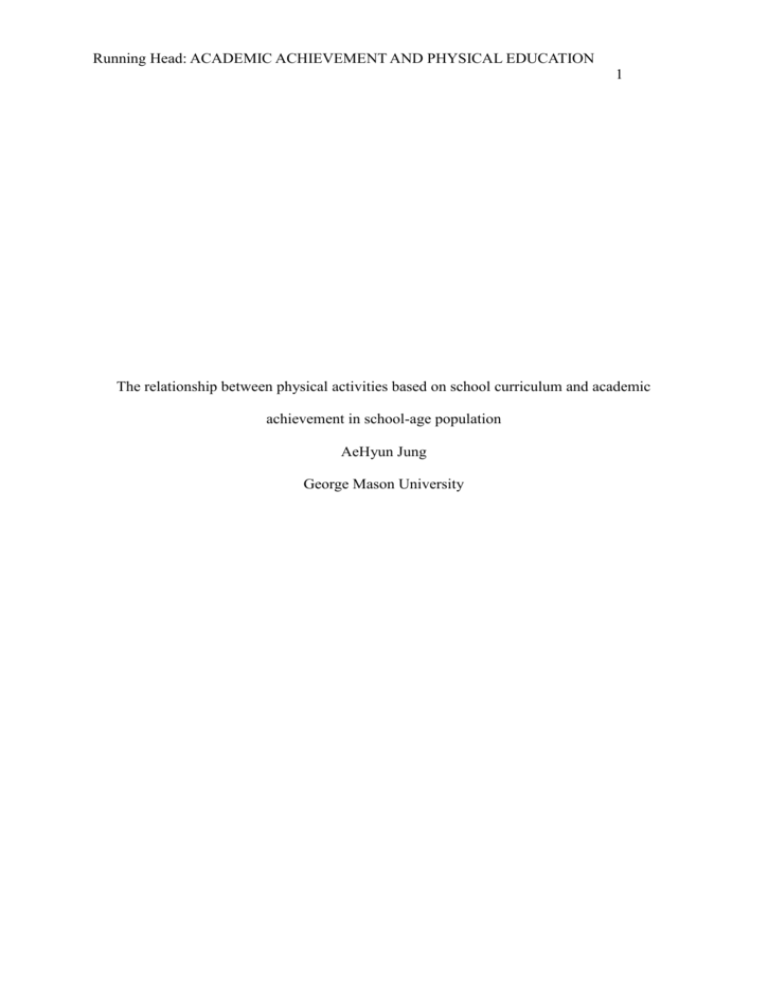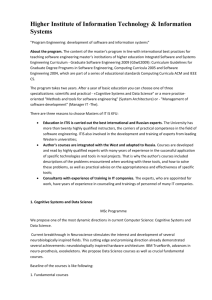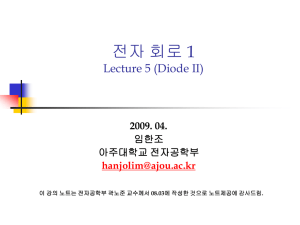Literature Review
advertisement

Running Head: ACADEMIC ACHIEVEMENT AND PHYSICAL EDUCATION 1 The relationship between physical activities based on school curriculum and academic achievement in school-age population AeHyun Jung George Mason University Running Head: ACADEMIC ACHIEVEMENT AND PHYSICAL EDUCATION 2 The relationship between physical activities based on school curriculum and academic achievement in school-age population Introduction Physical activities have positive impacts on students such as [healthy muscles and bones, improvement of muscular strength and endurance, reduced stress and anxiety] if students engage to physical activities at least 60 minutes every day (Rasberry et al., 2011, S11). In addition, numerous reviews and meta-analysis studies have shown that there are positive relationships between [physical activity with cognitive performance and academic achievement] (Ardoy, 2013, E52). Although, numerous studies have shown the positive outcomes of physical activities, a global tendency is to eliminate the physical education classes which include recess, classroom-based physical activities, and extracurricular physical activities during the school days. (Kall, 2014, 473; Rasberry et al., 2011, S11) The participation percentage of the physical education in each grade diminishes [approximately 50% in grades 1-5, to 25% in grade 8, to only 5% in grade 12](Coe, 2006, 1). Moreover, physical activity classes participation rate is decreasing through grades 9 (42.1%), 10 (30.4%), 11(20.0%), and 12 (20.1%)” (Coe, 2006,1). This is mainly because the schools’ budget pressures and suggests improving the standardized test scores and GPAs (Trost, 2007, 1). Therefore, students, parents and schools have the pressure about the physical activity classes in schools because of academic achievement. This phenomenon is amplified the interest about the impacts of physical education (Kwak, 2009,1). As a result, this literature review mainly focuses on the positive relationship between physical activity classes based on school curriculum and academic achievement. Moreover, this study discusses about other impacts of physical education. Finally, this literature review may have effects on school administrators to give attention to physical education for the Running Head: ACADEMIC ACHIEVEMENT AND PHYSICAL EDUCATION 3 improvement of academic achievement. Method Classification of studies This literature review includes ten studies that are related on the relationship between physical education and academic achievement. Specifically, these studies focus on different age groups that are based on the school-age population (e.g., elementary schools, middle schools and high schools.) Moreover, the ten studies concentrate on the physical activities based on school curriculum which included recesses, classroom-based physical activity and extracurricular physical activity. Findings Major finding - Academic achievement One study found the significant positive impacts of physical activity classes in school that focused on increasing the intensity and time of the physical activity (Ardoy, 2013, E55). This study divided three randomized groups: Control group, experimental group1, and experimental group2. CG enrolled in two physical activity sessions a week, EG1 enrolled in four physical activity sessions a week, and lastly, EG2 enrolled in four physical activity sessions a week and also increased the intensity of the physical activity (Ardoy, 2013, E54). The result showed that there are no significant outcomes when comparing Control group and Experimental group1. However, there are significant outcomes when comparing Control group and Experimental group2 (Ardoy, 2013, E55). Moreover, another study, “Associations between Physical Activity, Fitness, and Academic Achievement”, maintained the positive impacts of physical activities. According to the author, Lydia Kwak et al (2009), focused on Running Head: ACADEMIC ACHIEVEMENT AND PHYSICAL EDUCATION 4 not only the intensity of physical activities but also gender. For instance, “In girls, academic achievement was associated with vigorous physical activity and not mediated by fitness, whereas in boys only fitness was associated with academic achievement”(Kwak at al., 2009). However, four studies have indicated that physical activities in school do not have harmful effects on academic achievement. This is mainly because there is no significant relationship between physical education and academic achievement. Consequently, four studies have indicated that schools do not need to eliminate the physical activity classes (Trost, 2007; Coe et al., 2006; Kall et al., 2008). Similarly, “Effects of health-related physical education on academic achievement: Project SPARK” provided the negative outcomes of physical education. According to Sallis et al.(1998), “the significant intervention effects were not improvements in academic achievement scores” (Sallis et al., 1998, 132). Additional findings - Cognitive performance (cognitive skills and attitude) According to the author, Trost,S.G (2007), who is an associate professor from department of Nutrition and Exercise Sciences at Oregon State University, stressed the relationship between cognitive performance and physical education. If there are regular break time of physical activities in school may help to improve academic performance (Trost,2007,3). Moreover, providing physical activities have influences on improving cognitive performance and promoting on-task classroom behavior (Trost, 2007, 3). Similarly, another study concentrated the relationship between increasing intensity of physical activities and cognitive performance. The author, Ardoy et al. (2013), mentioned that “All cognitive performance indicators improved significantly in the adolescents from the EG2, compared with those from the CG and EG1” (Ardoy et al., 2013, 56). As a result, two studies have highlighted that the positive association between cognitive performance and Running Head: ACADEMIC ACHIEVEMENT AND PHYSICAL EDUCATION 5 physical activity classes in school curriculum. Although cognitive performance does not directly have an effect on academic achievement, cognitive performance can support improving students’ concentration skills and classroom behavior (Trost, 2007, 3). - Psychosocial effects Although nine studies mentioned the psychosocial effects, it did not emphasize the relationship between the psychosocial effects and physical education. For instance, “Physical activity might also improve mental health and self- efficacy and alleviate stress which may affect school achievement” (Kall, 2014, 477). However, unlike nine studies, Trudeau & Shephard (2008) highlighted the psychological effects of physical activity based on physical education. High level of physical activity is connected to better [body image, self-image and self-esteem] (Trudeau & Shephard, 2008, 7). Moreover, “The National Longitudinal Study of Adolescent Health found evidence of a positive association between physical activity and components of mental health, including self-esteem, emotional well-being, spirituality, and future expectations” (Trudeau & Shephard, 2008, 7). The purpose of emphasizing psychosocial effects in this literature review is that other studies have emphasized on preventing obesity (e.g., BMI) (Donnelly et al., 2013, 4; Ardoy et al., 2013, 55). Prevention of obesity is widely known fact of the impact of physical activities. Therefore, emphasizing the impacts of physical health is not enough to convince school administrators to increase the number of physical activity classes. In other words, It is needed the valuable influences of physical activities so that this outcome is able to protect decreasing physical activity classes in schools. Discussion: limitations and suggestions for future studies The main outcome of the literature review was that physical education may have Running Head: ACADEMIC ACHIEVEMENT AND PHYSICAL EDUCATION 6 positive effects on academic performance. Specifically, most studies have indicated that physical education does not have harmful effects on academic achievement (Trost, 2007; Coe et al., 2006; Kall et al., 2008). One study indicated that there is no relationship between physical education and academic achievement (Sallis et al., 1998, 132). Two studies found that academic achievement is highly related to the physical education focused on increasing the intensity of physical activity (Ardoy, 2013, E55; Kwak at al., 2009). Moreover, there are additional outcomes of the literature reviews such as Cognitive performance and psychosocial effects. Through this literature review, I was able to find the answer to my research question physical education may have positive effects on academic achievement for the school-age population which included elementary, middle, and high school students. Consequently, this literature review makes the school administrators understand clearly about the impacts of physical education. Specifically, school administrators become aware of the impacts of physical activity classes that will help students participating classes more enthusiastically as well as improving GPAs and standardized test score. Moreover, physical activities enable to make healthy mental and self-esteem (psychosocial effects). As a result, these potent positive impacts of physical education will help to increase or maintain the number of physical activity classes in schools. However, this literature review has several limitations. The first limitation is that the studies do not have the same research design. For instance, “Effects of health-related physical education on academic achievement: Project SPARK” and “A Physical Education trial improves adolescents’ cognitive performance and academic achievement: the EDUFIT study” use longitudinal designs but “The impact of a Physical Activity Intervention Program on Academic Achievement in a Swedish Elementary School Setting” and “Association between Physical Activity, Fitness, and Academic Achievement” use cross-sectional designs. Therefore, it was difficult to compare each study. As a result, future literature review should Running Head: ACADEMIC ACHIEVEMENT AND PHYSICAL EDUCATION 7 focus on one concept. The second limitation is that the range of the age is quite wide. I focused on school-age population. However, elementary school students, middle school students and high school students have different school curriculums and also growth development. Consequently, it is difficult to explain that there are possible positive impacts of physical education for academic achievement each age group. Moreover, there are lack of studies focused on high school students. The only one study focuses on high school students from my literature review (Rasberry et al., 2011). As a result, Future studies should divide specific age groups as well as concentrate on high school students because of the lack of studies. Lastly, most studies have indicated that there are no harmful effects of physical activity classes based on schools’ curriculums on academic achievement (Trost, 2007; Sallis et al., 1998; Coe et al., 2006; Kall et al., 2008). There is not enough evidence to convince school administrators to increase physical activity classes. However, there is possible evidence where two studies have shown a positive relationship between academic achievement and physical education focused on increasing the intensity of physical activity (Ardoy, 2013, E55; Kwak at al., 2009). As a result, future studies should focus on the intensity of the physical activity classes in schools for this approach help convince school administrators to increase physical activity classes. Conclusion The purpose of this literature review is to find out the positive relationship between physical activity classes based on school curricula and academic achievement. The results showed that two studies have had positive correlations between physical education and academic performance, and three studies have indicated that there are no significant effects of physical education on academic achievement. Lastly, one study maintained that there is no the relationship between physical education and academic achievement. Although, most Running Head: ACADEMIC ACHIEVEMENT AND PHYSICAL EDUCATION 8 studies have shown that there is not a strong correlation between physical education and academic achievement, two studies have shown the positive relationship between academic achievement and physical education when focusing on increasing the intensity of physical activity. Therefore, future researches should focus on the intensity of the physical activity classes in schools to help convince school administrators to increase physical activity classes. Word count: 1711 References Ardoy, D., Fernández-Rodríguez, J., Jiménez-Pavón, D., Castillo, R., Ruiz, J., & Ortega, F. (2013). A Physical Education trial improves adolescents' cognitive performance and academic achievement: The EDUFIT study. Scandinavian Journal of Medicine & Science in Sports, E52-E61. Coe, D., Pivarnik, J., Womack, C., Reeves, M., & Malina, R. (2006). Effect Of Physical Education And Activity Levels On Academic Achievement In Children. Medicine & Science in Sports & Exercise, 38(8), 1515-1519. Retrieved October 8, 2014, from http://www.ncbi.nlm.nih.gov/pubmed/16888468 Donnelly, J., Greene, J., Gibson, C., Sullivan, D., Hansen, D., Hillman, C. Washburn, R. (2013). Physical activity and academic achievement across the curriculum (A PAAC): Rationale and design of a 3-year, cluster-randomized trial. BMC Public Health, 13(307), 307-307. Kall, L., Nilsson, M., & Linden, T. (2014). The impact of a physical activity intervention program on academic achievement in a Swedish elementary school setting. Journal of School Health, 84(8), 473-480. Retrieved October 15, 2014, from http://onlinelibrary.wiley.com Kwak, L., Kremers, S. P., Bergman, P., Ruiz, J. R., Rizzo, N. S., & Sjöström, M. (2009). Associations between physical activity, fitness, and academic achievement. The Journal of pediatrics, 155(6), 914-918. Rasberry, C., Lee, S., Robin, L., Laris, B., Russell, L., Coyle, K., & Nihiser, A. (2011). The Association Between School-based Physical Activity, Including Physical Education, And Academic Performance: A Systematic Review of the Literature☆☆☆. Preventive Medicine, 52(Supplement), S10-S20. Retrieved October 7, 2014, from Running Head: ACADEMIC ACHIEVEMENT AND PHYSICAL EDUCATION 9 http://www.sciencedirect.com. Sallis, J., Mckenzie, T., Kolody, B., Lewis, M., Marshall, S., & Rosengard, P. (1998). Effects of Health-Related Physical Education on Academic Achievement: Project SPARK. Research Quarterly for Exercise and Sport, 70(2), 127-134. Retrieved October 24, 2014, from http://www.tandfonline.com Stevens, T. A., To, Y., Stevenson, S. J., & Lochbaum, M. R. (2008). The importance of physical activity and physical education in the prediction of academic achievement. Journal of Sport Behavior, 31(4), 368-388. Trost, S. G. (2007). Active education: Physical education, physical activity and academic performance. Trudeau, F., & Shephard, R. (2008). Physical Education, School Physical Activity, School Sports And Academic Performance. International Journal of Behavioral Nutrition and Physical Activity, 10(1186), 5-10. Retrieved October 18, 2014, from http://creativecommons.org/licenses/by/2.0






